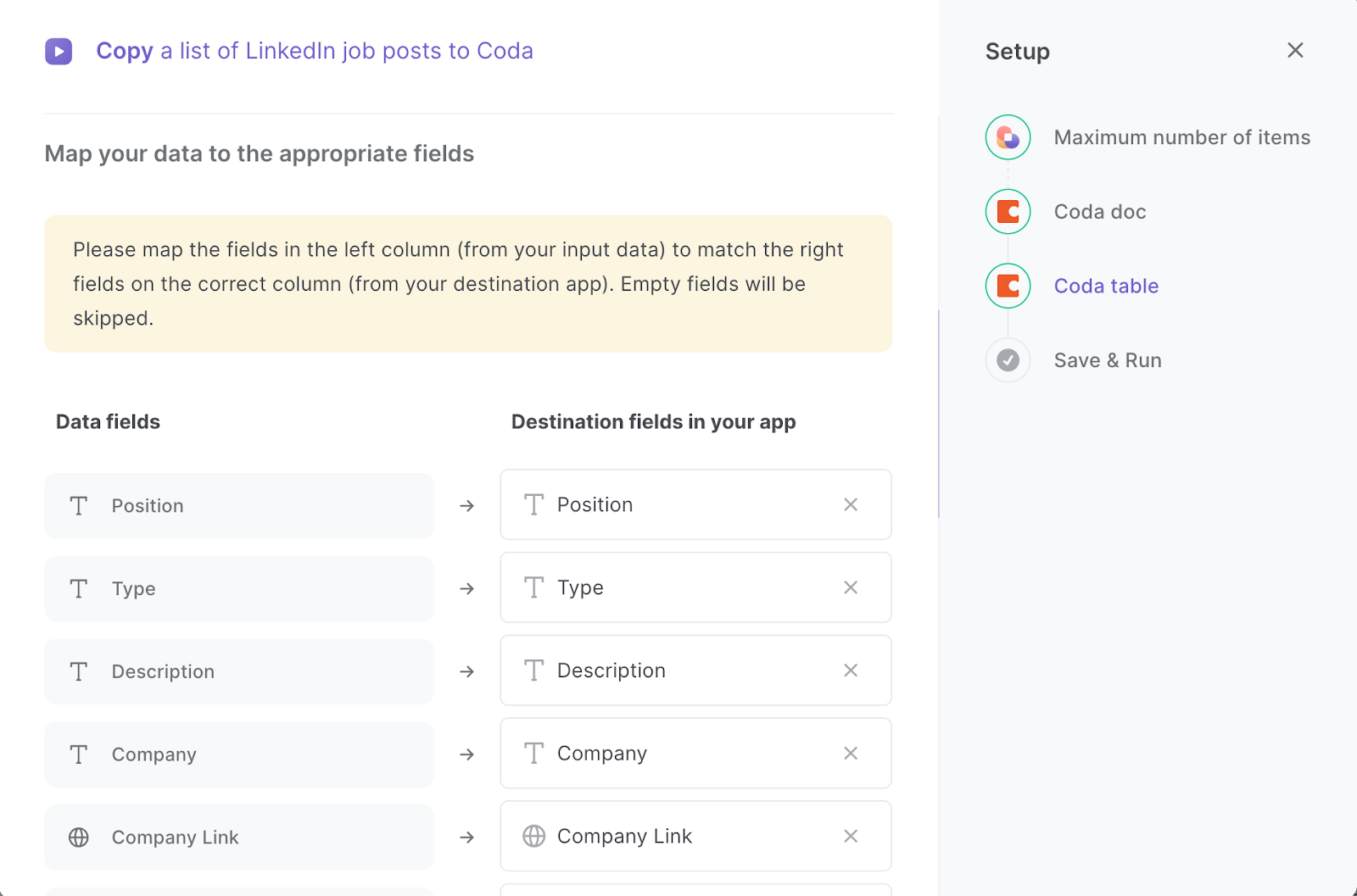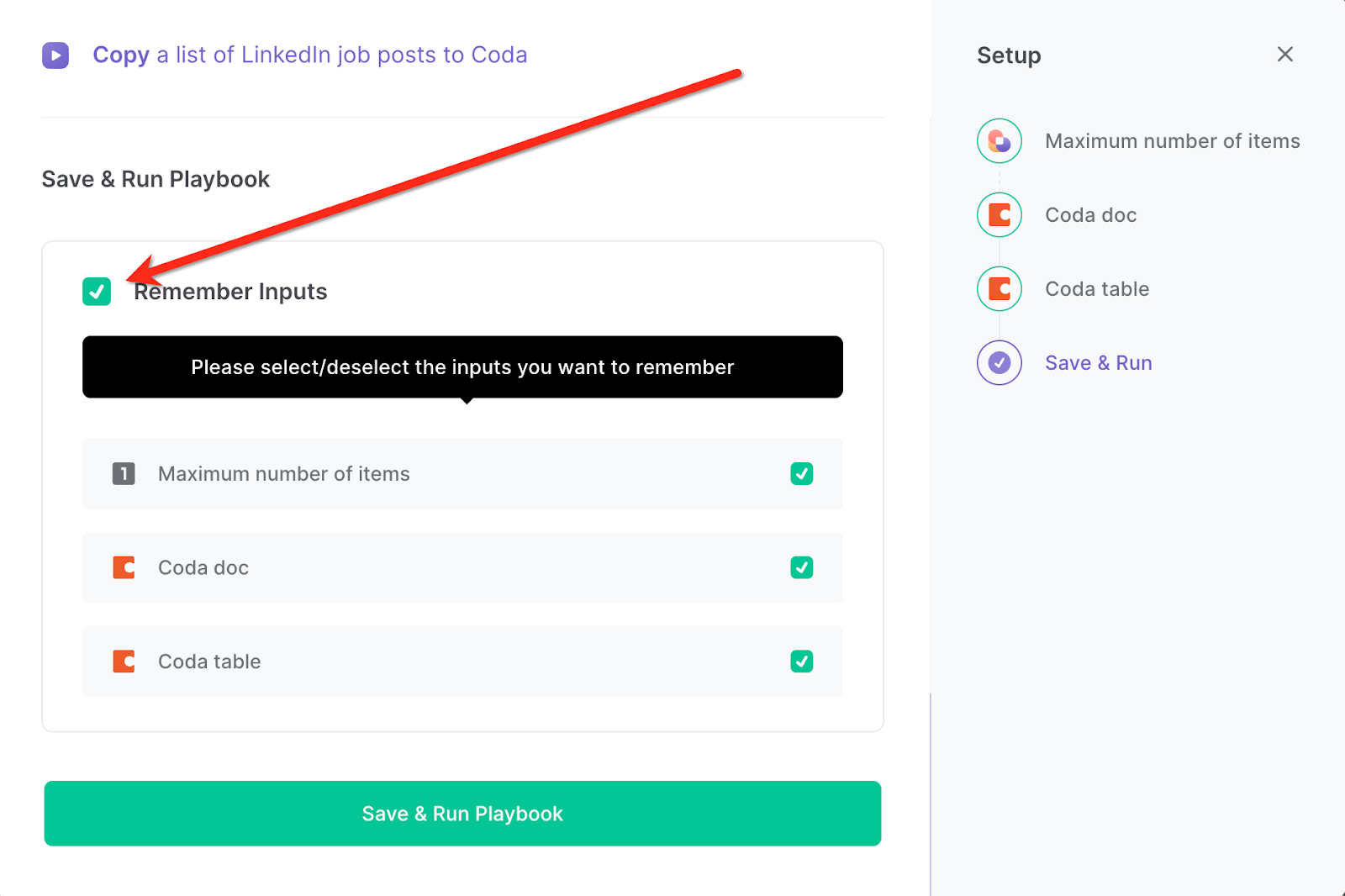Copy a list of LinkedIn job posts to Coda
This is a Bardeen playbook. It's a pre-built automation template you can run in one-click to perform a repetitive task. Get started with our free Chrome extension.
Explore other automations
This playbook has been deprecated.
Explore Bardeen's playbook catalog for other automations or build your own.

How does this automation work?
Bardeen's Playbook for copying LinkedIn job posts to Coda is designed to help recruiting professionals and HR departments efficiently gather potential job listings without manual data entry. Leveraging advanced scraping technology, this workflow automatically extracts job post data from LinkedIn and populates them into a Coda table, enabling users to streamline their recruitment process and manage their candidate pipeline more effectively.
Here's how you can automate the collection of job postings from LinkedIn into Coda:
- Step 1: Scrape LinkedIn job posts - The Scraper is used to extract job post listings from LinkedIn's active job search page. Specify the number of job posts you want to scrape with the 'maxItems' parameter.
- Step 2: Deep scrape job details - Bardeen performs a deeper scrape in the background to gather detailed information from each individual job post link using a specialized LinkedIn scraper template.
- Step 3: Add to Coda table - Finally, the scraped job post data is added to your specified Coda document and table, creating a structured and actionable list of job opportunities.
How to run the playbook
If you're tired of spending hours searching for job listings online and manually entering the data into your database, you're not alone. The good news is that this automation can help.
By utilizing deep scraping technology, it automatically gathers job listings from your LinkedIn job search page and adds them to a Coda table.
Whether you're a job seeker or a recruiter, this automation is a game-changer. Job seekers can use it to stay organized and keep track of job listings they're interested in, while recruiters can use it to streamline their candidate sourcing process.
Here’s how this automation works.
Please be aware that the excessive or abusive use of extensions, bots, or automation tools on some websites can lead to penalties, including temporary or even permanent restrictions on your account. We recommend you read and adhere to the specific terms of the websites you are visiting and using to avoid any disruptions or issues. We do not assume any responsibility for the consequences of abuse.
Step 1: Create a Coda table
The first step is to set up a Coda table with all the information you want to store from job posts.

Bardeen will extract information from the job post links like position, description, type, company information and links, hiring person information and more.
Step 2: Install the extension and run the playbook
You will be redirected to install the browser extension when you run it for the first time. Bardeen will also prompt you to integrate Coda.
Click the “Pin it” button at the top of this page to get this automation saved to your Playbooks. If it’s your first time using Bardeen, you will be redirected to install the extension.
Click on the playbook card, and the setup flow will start.
You will be asked to specify your Coda table and the maximum number of items you wish to extract. After you choose the database and maximum number of items, you will get a prompt to map the information to the fields in Coda.

The left side consists of all the fields Bardeen will scrape for you. On the right side, specify the fields in Coda that you want to associate with the information on the left. If you don’t want a piece of information, leave that field empty, and it will be skipped. That’s it!
Click on “Save Input” and checkmark Coda. You can edit Inputs later by hovering over the playbook.

Step 3: Start saving!
When you want to copy a list of LinkedIn job posts, activate Bardeen (or hit OPTION + B) and run this playbook. It will use deep scraping on a LinkedIn job list from the job search page and add them to a Coda table.
This automation is fantastic for job seekers who can use this automation to stay on top of job opportunities that align with their career goals. By automating the process of adding job listings to a Coda table, job seekers can focus on tailoring their applications and preparing for interviews instead of tedious data entry.
Recruiters can also use this automation to quickly gather relevant job listings and store them in a centralized database. This saves time and effort, allowing recruiters to focus on more important tasks like screening candidates and scheduling interviews.
In addition, hiring managers can use this automation to keep track of job postings and the candidates who have applied for them. By having all the information in one place, hiring managers can easily assess the progress of each job posting and make more informed hiring decisions.
You can also edit the playbook and add your next action to further customize the automation.
Find more Coda integrations, LinkedIn integrations, and Coda and LinkedIn integrations.
You can also find more about how to increase your personal productivity and automate your recruitment process.
Your proactive teammate — doing the busywork to save you time
.svg)
Integrate your apps and websites
Use data and events in one app to automate another. Bardeen supports an increasing library of powerful integrations.
.svg)
Perform tasks & actions
Bardeen completes tasks in apps and websites you use for work, so you don't have to - filling forms, sending messages, or even crafting detailed reports.
.svg)
Combine it all to create workflows
Workflows are a series of actions triggered by you or a change in a connected app. They automate repetitive tasks you normally perform manually - saving you time.
FAQs
You can create a Bardeen Playbook to scrape data from a website and then send that data as an email attachment.
Unfortunately, Bardeen is not able to download videos to your computer.
Exporting data (ex: scraped data or app data) from Bardeen to Google Sheets is possible with our action to “Add Rows to Google Sheets”.
There isn't a specific AI use case available for automatically recording and summarizing meetings at the moment
Please follow the following steps to edit an action in a Playbook or Autobook.
Cases like this require you to scrape the links to the sections and use the background scraper to get details from every section.








